Impact of frequency shift on nonlinear compensation using optical phase conjugation for M-QAM signals
Nonlinear compensation using optical phase conjugation (OPC) have been considered a promising technique to increase the reach of high-Speed fiber-optic transmission systems. OPC-based nonlinear compensation employs an optical phase conjugation located at a middle of the fiber link to generate a complexed conjugated signal with respect to the signal in the first half of the link for propagation in the second half. OPC technique assumes a symmetry for signal propagating in the first and second half to obtain a perfect nonlinear and chromatic dispersion. However, as most of practical OPC schemes are realized by nonlinear effects such as four-wave mixing or a combination of second-harmonic generation and difference frequency generation, the frequency shift induced by OPC affects the signal symmetrical requirement for nonlinear compensation because the chromatic dispersion is different for the first and second half transmissions. In this paper, we investigate the impact of frequency shift on the nonlinear compensation using OPC for high symbol rate, high level modulation format signals. This will be important to understand the tolerance of the OPC techniques against such a practical condition for actual system implementations
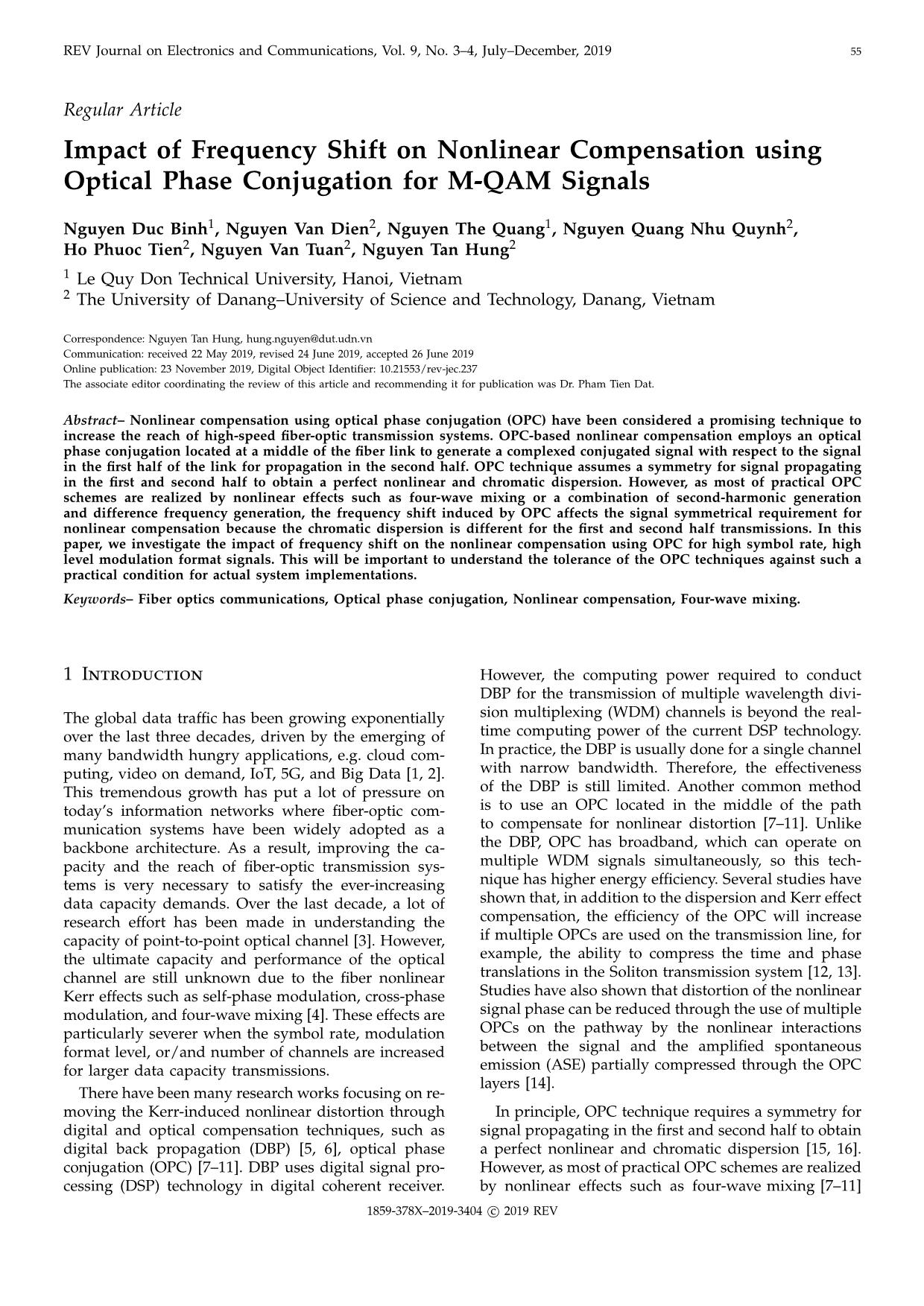
Trang 1
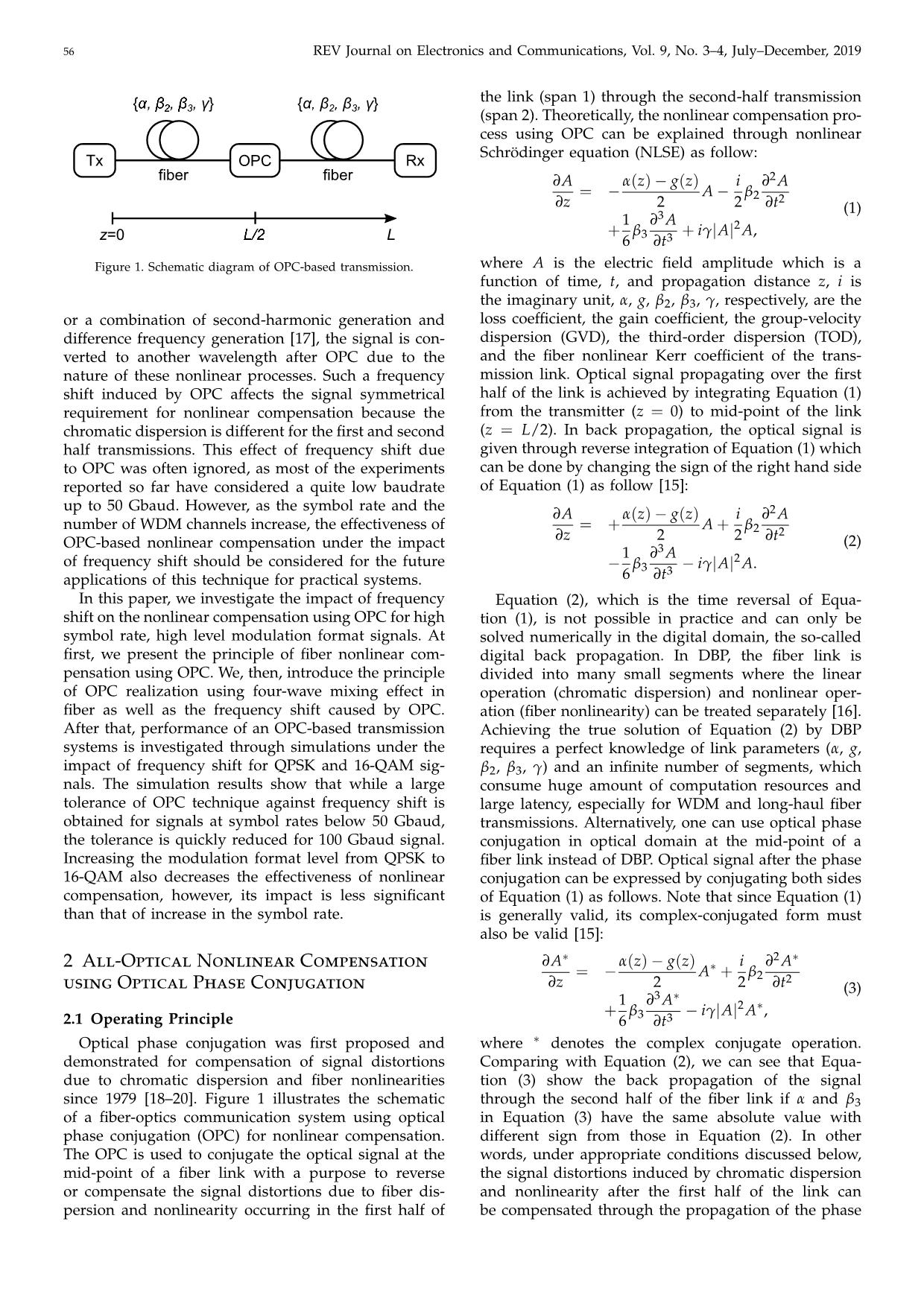
Trang 2
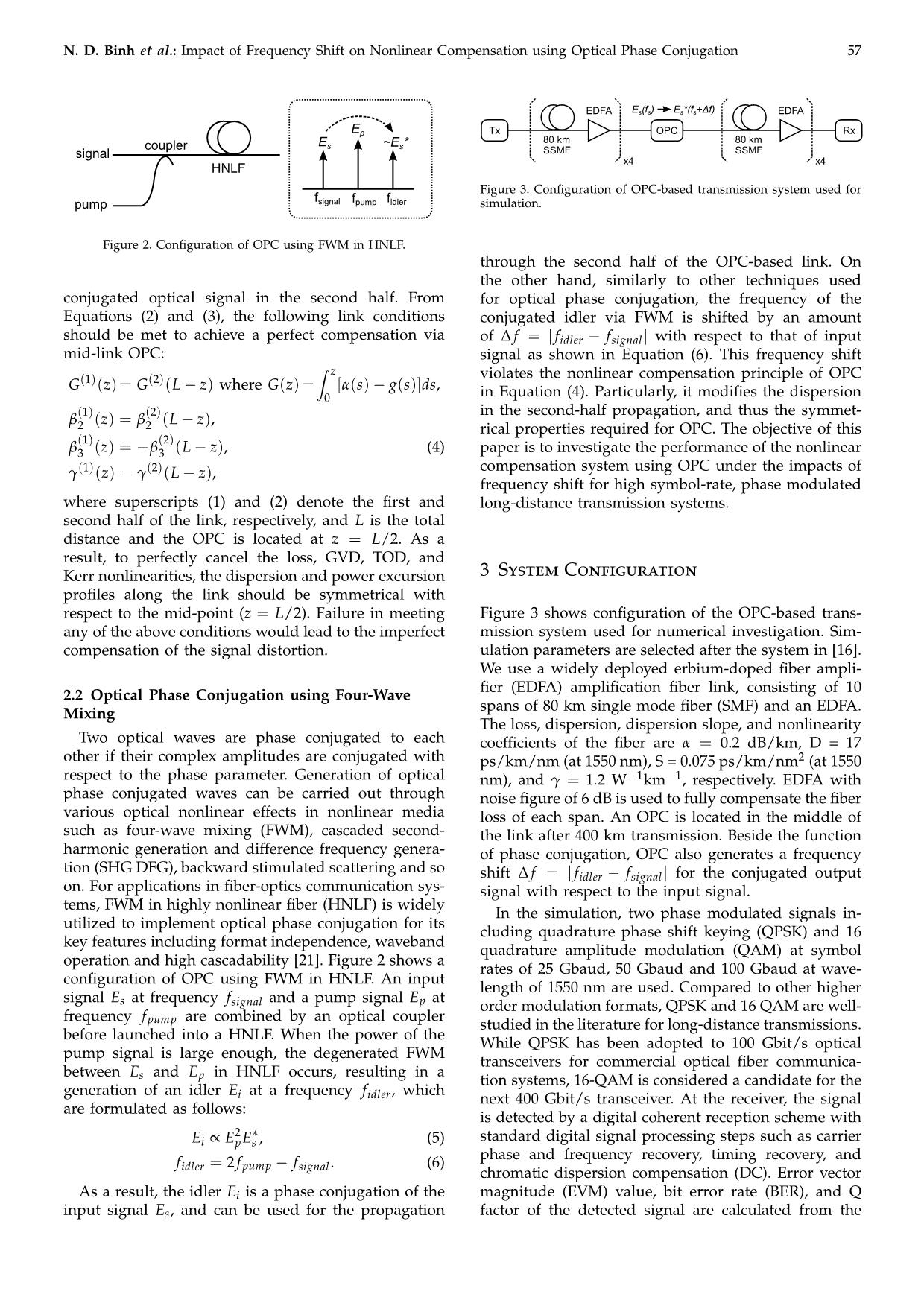
Trang 3
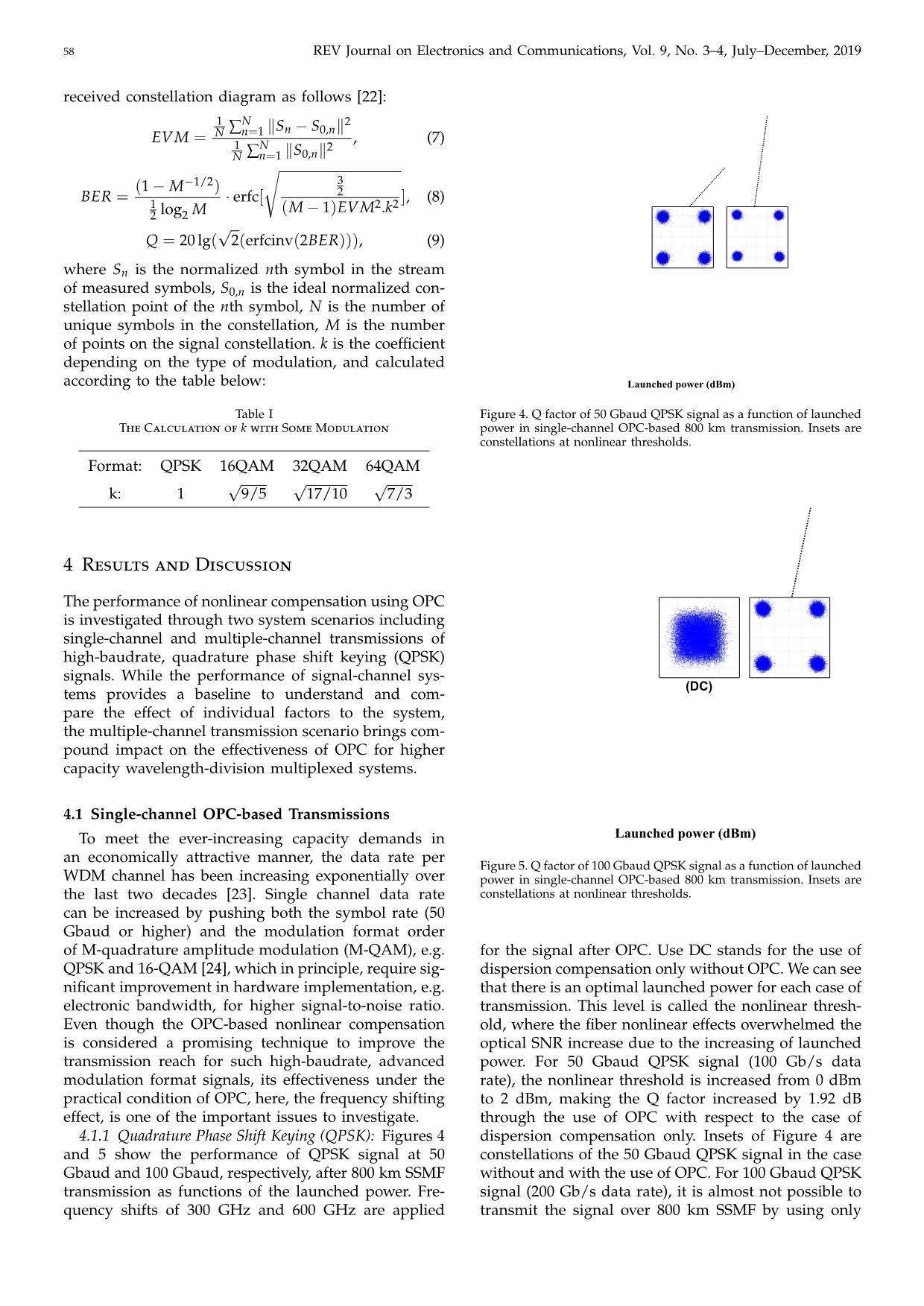
Trang 4
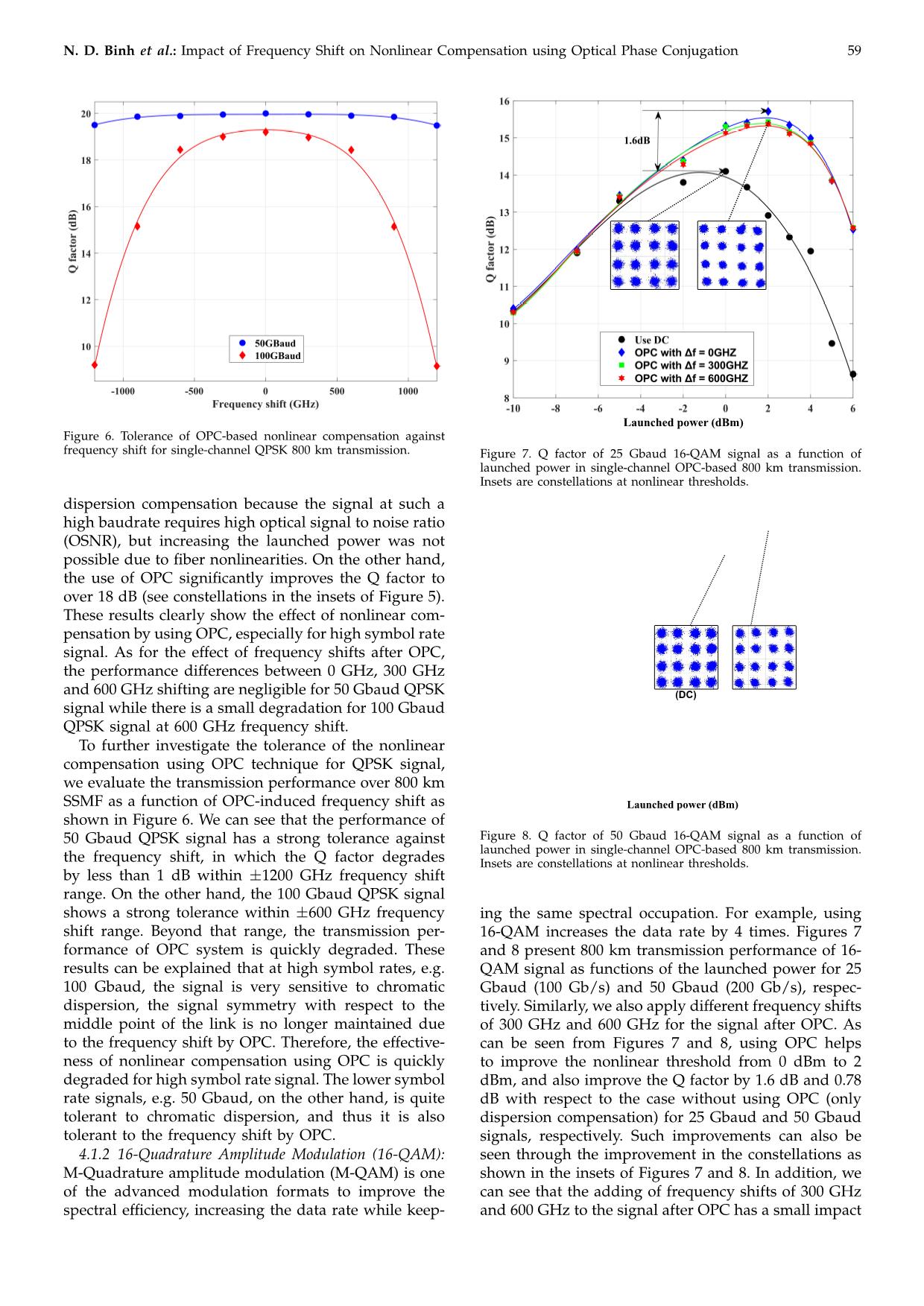
Trang 5
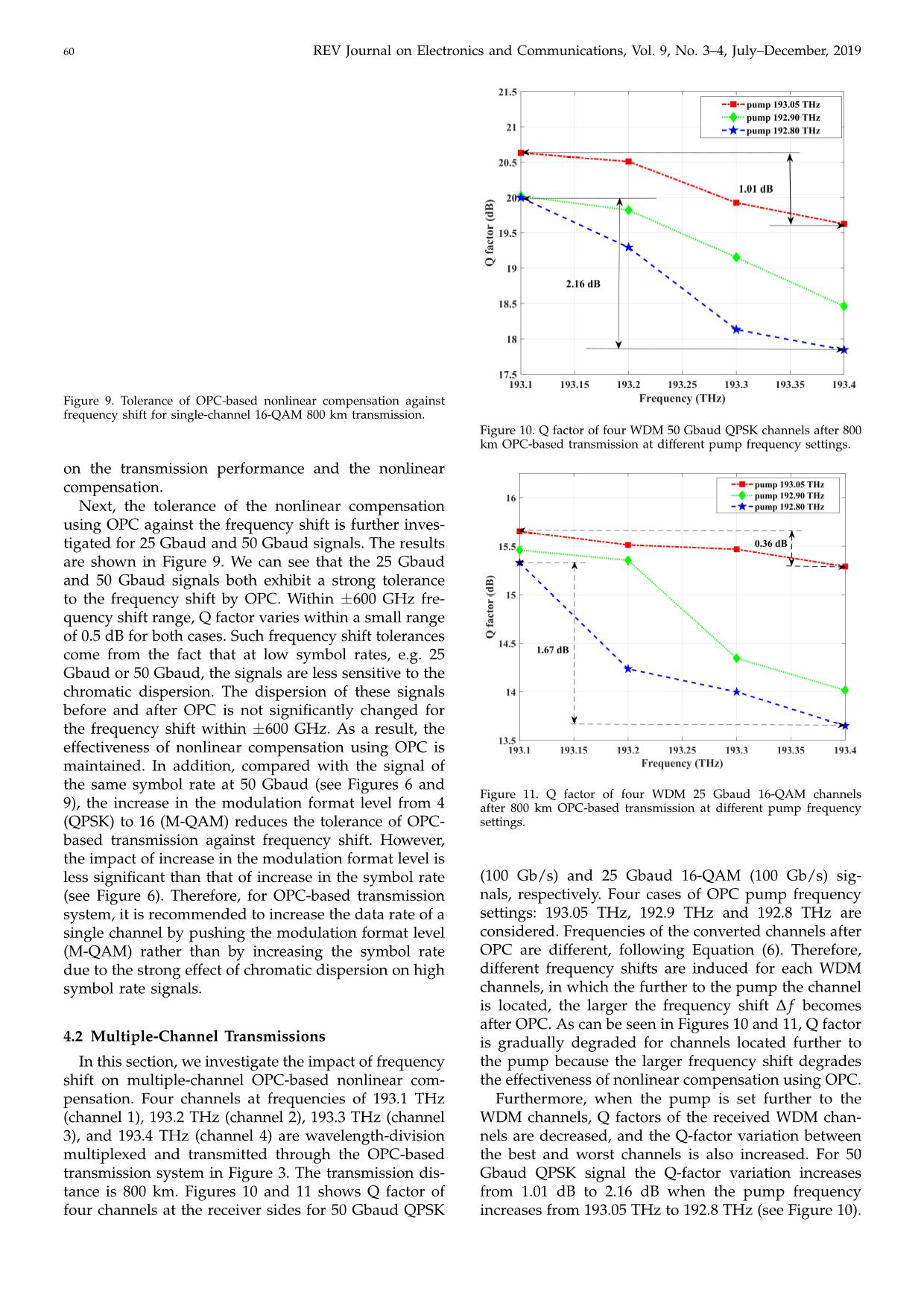
Trang 6
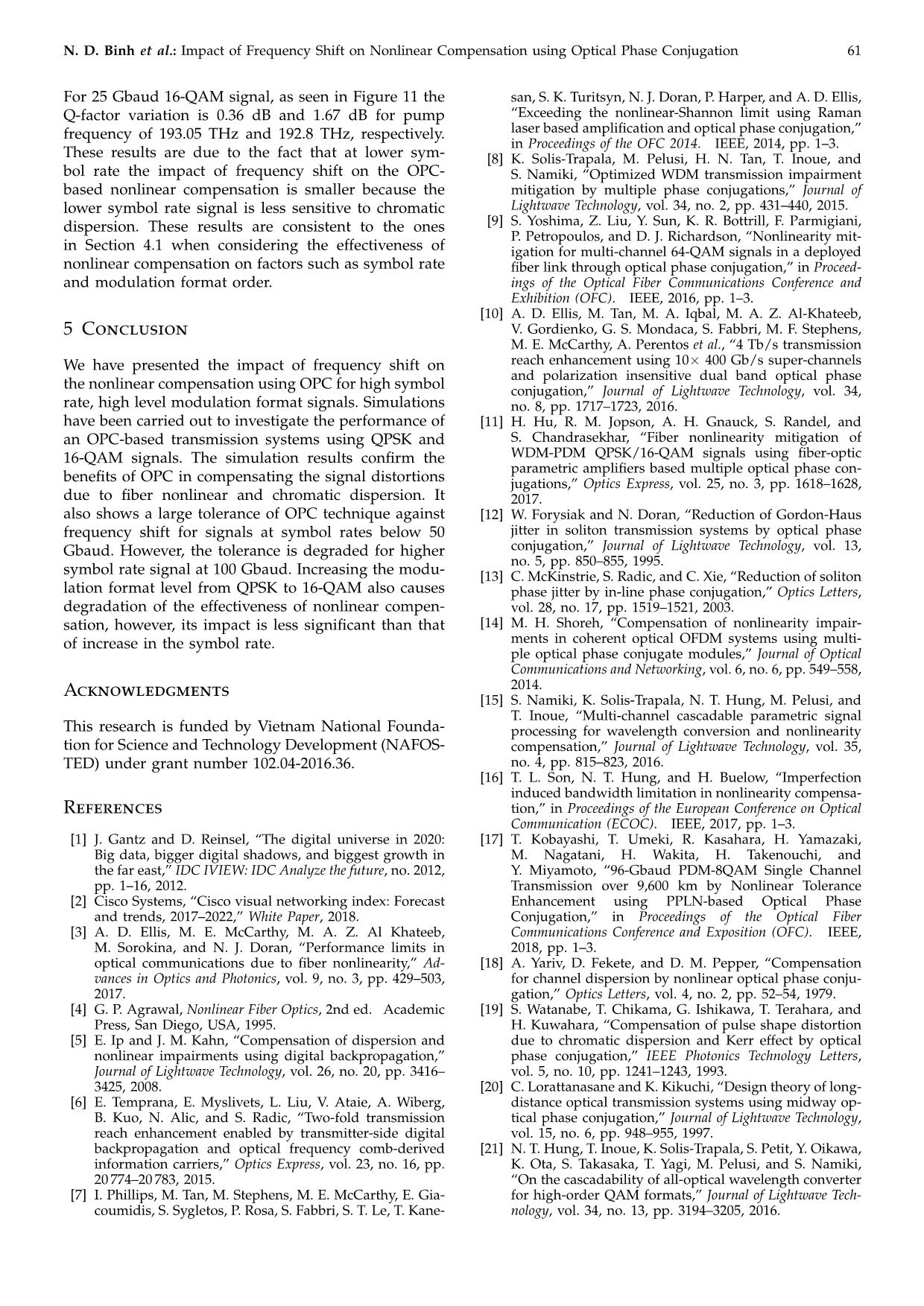
Trang 7

Trang 8
Tóm tắt nội dung tài liệu: Impact of frequency shift on nonlinear compensation using optical phase conjugation for M-QAM signals
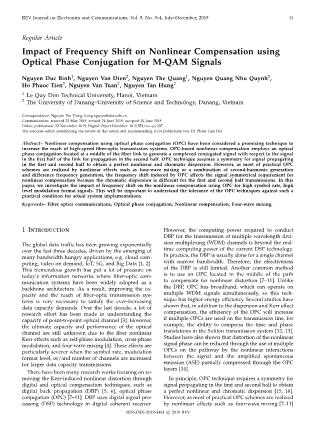
and worst channels is also increased. For 50 transmission system in Figure 3. The transmission dis- Gbaud QPSK signal the Q-factor variation increases tance is 800 km. Figures 10 and 11 shows Q factor of from 1.01 dB to 2.16 dB when the pump frequency four channels at the receiver sides for 50 Gbaud QPSK increases from 193.05 THz to 192.8 THz (see Figure 10). N. D. Binh et al.: Impact of Frequency Shift on Nonlinear Compensation using Optical Phase Conjugation 61 For 25 Gbaud 16-QAM signal, as seen in Figure 11 the san, S. K. Turitsyn, N. J. Doran, P. Harper, and A. D. Ellis, Q-factor variation is 0.36 dB and 1.67 dB for pump “Exceeding the nonlinear-Shannon limit using Raman frequency of 193.05 THz and 192.8 THz, respectively. laser based amplification and optical phase conjugation,” in Proceedings of the OFC 2014. IEEE, 2014, pp. 1–3. These results are due to the fact that at lower sym- [8] K. Solis-Trapala, M. Pelusi, H. N. Tan, T. Inoue, and bol rate the impact of frequency shift on the OPC- S. Namiki, “Optimized WDM transmission impairment based nonlinear compensation is smaller because the mitigation by multiple phase conjugations,” Journal of lower symbol rate signal is less sensitive to chromatic Lightwave Technology, vol. 34, no. 2, pp. 431–440, 2015. dispersion. These results are consistent to the ones [9] S. Yoshima, Z. Liu, Y. Sun, K. R. Bottrill, F. Parmigiani, P. Petropoulos, and D. J. Richardson, “Nonlinearity mit- in Section 4.1 when considering the effectiveness of igation for multi-channel 64-QAM signals in a deployed nonlinear compensation on factors such as symbol rate fiber link through optical phase conjugation,” in Proceed- and modulation format order. ings of the Optical Fiber Communications Conference and Exhibition (OFC). IEEE, 2016, pp. 1–3. [10] A. D. Ellis, M. Tan, M. A. Iqbal, M. A. Z. Al-Khateeb, 5 Conclusion V. Gordienko, G. S. Mondaca, S. Fabbri, M. F. Stephens, M. E. McCarthy, A. Perentos et al., “4 Tb/s transmission We have presented the impact of frequency shift on reach enhancement using 10× 400 Gb/s super-channels and polarization insensitive dual band optical phase the nonlinear compensation using OPC for high symbol conjugation,” Journal of Lightwave Technology, vol. 34, rate, high level modulation format signals. Simulations no. 8, pp. 1717–1723, 2016. have been carried out to investigate the performance of [11] H. Hu, R. M. Jopson, A. H. Gnauck, S. Randel, and an OPC-based transmission systems using QPSK and S. Chandrasekhar, “Fiber nonlinearity mitigation of 16-QAM signals. The simulation results confirm the WDM-PDM QPSK/16-QAM signals using fiber-optic parametric amplifiers based multiple optical phase con- benefits of OPC in compensating the signal distortions jugations,” Optics Express, vol. 25, no. 3, pp. 1618–1628, due to fiber nonlinear and chromatic dispersion. It 2017. also shows a large tolerance of OPC technique against [12] W. Forysiak and N. Doran, “Reduction of Gordon-Haus frequency shift for signals at symbol rates below 50 jitter in soliton transmission systems by optical phase Gbaud. However, the tolerance is degraded for higher conjugation,” Journal of Lightwave Technology, vol. 13, no. 5, pp. 850–855, 1995. symbol rate signal at 100 Gbaud. Increasing the modu- [13] C. McKinstrie, S. Radic, and C. Xie, “Reduction of soliton lation format level from QPSK to 16-QAM also causes phase jitter by in-line phase conjugation,” Optics Letters, degradation of the effectiveness of nonlinear compen- vol. 28, no. 17, pp. 1519–1521, 2003. sation, however, its impact is less significant than that [14] M. H. Shoreh, “Compensation of nonlinearity impair- of increase in the symbol rate. ments in coherent optical OFDM systems using multi- ple optical phase conjugate modules,” Journal of Optical Communications and Networking, vol. 6, no. 6, pp. 549–558, Acknowledgments 2014. [15] S. Namiki, K. Solis-Trapala, N. T. Hung, M. Pelusi, and T. Inoue, “Multi-channel cascadable parametric signal This research is funded by Vietnam National Founda- processing for wavelength conversion and nonlinearity tion for Science and Technology Development (NAFOS- compensation,” Journal of Lightwave Technology, vol. 35, TED) under grant number 102.04-2016.36. no. 4, pp. 815–823, 2016. [16] T. L. Son, N. T. Hung, and H. Buelow, “Imperfection induced bandwidth limitation in nonlinearity compensa- References tion,” in Proceedings of the European Conference on Optical Communication (ECOC). IEEE, 2017, pp. 1–3. [1] J. Gantz and D. Reinsel, “The digital universe in 2020: [17] T. Kobayashi, T. Umeki, R. Kasahara, H. Yamazaki, Big data, bigger digital shadows, and biggest growth in M. Nagatani, H. Wakita, H. Takenouchi, and the far east,” IDC IVIEW: IDC Analyze the future, no. 2012, Y. Miyamoto, “96-Gbaud PDM-8QAM Single Channel pp. 1–16, 2012. Transmission over 9,600 km by Nonlinear Tolerance [2] Cisco Systems, “Cisco visual networking index: Forecast Enhancement using PPLN-based Optical Phase and trends, 2017–2022,” White Paper, 2018. Conjugation,” in Proceedings of the Optical Fiber [3] A. D. Ellis, M. E. McCarthy, M. A. Z. Al Khateeb, Communications Conference and Exposition (OFC). IEEE, M. Sorokina, and N. J. Doran, “Performance limits in 2018, pp. 1–3. optical communications due to fiber nonlinearity,” Ad- [18] A. Yariv, D. Fekete, and D. M. Pepper, “Compensation vances in Optics and Photonics, vol. 9, no. 3, pp. 429–503, for channel dispersion by nonlinear optical phase conju- 2017. gation,” Optics Letters, vol. 4, no. 2, pp. 52–54, 1979. [4] G. P. Agrawal, Nonlinear Fiber Optics, 2nd ed. Academic [19] S. Watanabe, T. Chikama, G. Ishikawa, T. Terahara, and Press, San Diego, USA, 1995. H. Kuwahara, “Compensation of pulse shape distortion [5] E. Ip and J. M. Kahn, “Compensation of dispersion and due to chromatic dispersion and Kerr effect by optical nonlinear impairments using digital backpropagation,” phase conjugation,” IEEE Photonics Technology Letters, Journal of Lightwave Technology, vol. 26, no. 20, pp. 3416– vol. 5, no. 10, pp. 1241–1243, 1993. 3425, 2008. [20] C. Lorattanasane and K. Kikuchi, “Design theory of long- [6] E. Temprana, E. Myslivets, L. Liu, V. Ataie, A. Wiberg, distance optical transmission systems using midway op- B. Kuo, N. Alic, and S. Radic, “Two-fold transmission tical phase conjugation,” Journal of Lightwave Technology, reach enhancement enabled by transmitter-side digital vol. 15, no. 6, pp. 948–955, 1997. backpropagation and optical frequency comb-derived [21] N. T. Hung, T. Inoue, K. Solis-Trapala, S. Petit, Y. Oikawa, information carriers,” Optics Express, vol. 23, no. 16, pp. K. Ota, S. Takasaka, T. Yagi, M. Pelusi, and S. Namiki, 20 774–20 783, 2015. “On the cascadability of all-optical wavelength converter [7] I. Phillips, M. Tan, M. Stephens, M. E. McCarthy, E. Gia- for high-order QAM formats,” Journal of Lightwave Tech- coumidis, S. Sygletos, P. Rosa, S. Fabbri, S. T. Le, T. Kane- nology, vol. 34, no. 13, pp. 3194–3205, 2016. 62 REV Journal on Electronics and Communications, Vol. 9, No. 3–4, July–December, 2019 [22] W. Freude, R. Schmogrow, B. Nebendahl, M. Win- Nguyen Quang Nhu Quynh received the ter, A. Josten, D. Hillerkuss, S. Koenig, J. Meyer, B.E. and M.E. degrees from The University of M. Dreschmann, M. Huebner et al., “Quality metrics for Danang - University of Science and Technol- optical signals: eye diagram, Q-factor, OSNR, EVM and ogy, Danang, Vietnam in 2002 and 2008, re- BER,” in Proceedings of the 14th International Conference on spectively. She received the Ph.D. degree from the University of Electro-Communications, Transparent Optical Networks (ICTON). IEEE, 2012, pp. Tokyo, Japan under Japanese Government 1–4. (Monbukagakusho) Scholarship in 2016. Dr. [23] P. J. Winzer and D. T. Neilson, “From scaling disparities Quynh is currently a lecturer/researcher in to integrated parallelism: A decathlon for a decade,” The University of Danang - University of Sci- Journal of Lightwave Technology, vol. 35, no. 5, pp. 1099– ence and Technology, Vietnam. Her research Nguyen Quang Nhu Quynh received the B.E. and M.E. degrees from The University of Danang – University of Science and Technology, Danang, Vietnam in 2002 and 2008, 1115, 2017. respectively.interests She received includethe Ph.D. degree from high-speed the University of optical communications and all-optical Electro-Communications, Tokyo, Japan under Japanese Government (Monbukagakusho)signal Scholarship processing in 2016. Dr. Quynh is currently technologies. a lecturer/researcher in [24] P. J. Winzer, “High-spectral-efficiency optical modulation The University of Danang - University of Science and Technology, Vietnam. Her research interests include high-speed optical communications and all-optical signal processing technologies. formats,” Journal of Lightwave Technology, vol. 30, no. 24, pp. 3824–3835, 2012. 5. Hồ Phước Tiến Ho Phuoc Tien received the Engineer degree 1. Nguyen Duc Binh in 2004 from Ho Chi Minh City University Nguyen Duc Binh was born in 1984. He re- of Technology and the Master and Ph.D. de- ceived B.E. degree from Le Quy Don Technical grees, in 2006 and 2010 respectively, from University of Grenoble. Dr. Tien is now a lec- University, Viet Nam, in 2008, and M.E. degree in 2013 from Le Quy Don Technical Univer- turer/researcher at The Univeristy of Danang sity, Viet Nam. From 2013 to 2015, He has - University of Science and Technology. His worked as an operator and manager engineer research interests include signal processing, of optical transmission network at the High- image/video super resolution, visual atten- tech Communication Center, Communications tion and recognition. Command. He is currently a Ph.D. student at Le Quy Don Technical University, Hanoi, Nguyen Duc Binh was born in 1984. He received B.E. degree from Le QuyVietnam. Don Technical University, Viet Nam, in 2008, and M.E. degree in 2013 from Le Quy Don Technical University, Viet Nam. From 2013 to 2015, He has worked as an operator and manager engineer of optical transmission network at the Hightech Communication Center, Communications Command. He is currently a Ph.D student at Le Quy Don Technical University, Hanoi, Vietnam. Nguyen Van Tuan was born in Danang, Viet- 2. Nguyen Van Dien nam, in 1963. He received the B.E. degree from Nguyen Van Dien received the B.E. degree The University of Danang-University of Sci- from Ho Chi Minh City University of Tech- ence and Technology, Vietnam in 1985, and the nology and the Diplom-Ingenieur degree from M.E. and Ph.D. degrees from The Hanoi Uni- University of Stuttgart, Germanyin 2003 and versity of Science and Technology, Vietnam in 2011, respectively. He is now a Ph.D. candi- 1998 and 2003, respectively. He worked as a date at The Univeristy of Danang - Univer- postdoctoral fellow at the Department of Elec- sity of Science and Technology. His research tronic and Communication, Sejong University, Korea. He is currently an Assosiate Professor interests includefiber-optics communications, Nguyen Van Tuan was born in Danang, Vietnam, in 1963. He received the B.E.at degree The University of Danang-University of Sci- radio-over-fiber and microwave photonics for from The University of Danang-University of Science and Technology, Vietnam in 1985, andence the M.E. and Ph.D. and degrees from Technology The Hanoi University of Science and whereTechnology, he works as the Dean of the Department next-generation access networks. Vietnam in 1998 and 2003, respectively. He worked as a postdoctoral fellow at the DepartmentofElectronic of Electronic and Communication, and Sejong University, Telecommunication Korea. He is Engineering. currently an Assosiate Professor at The University of Danang-University of Science and Nguyen Van Dien received the B.E. degree from Ho Chi Minh City University of Technology where he works as the Dean of the Department of Electronic and Technology and the Diplom-Ingenieur degree from University of Stuttgart, Germanyin Telecommunication Engineering. 2003 and 2011, respectively. He is now a Ph.D. candidate at The Univeristy of Danang - University of Science and Technology. His research interests includefiber-optics communications, radio-over-fiber and microwave photonics for next-generation access networks. 7. Nguyen Tan Hung 3. Nguyen The Quang Nguyen Tan Hung Nguyen The Quang was born in 1978. He was born in Danang, Viet- received the B.E. degree from National De- nam, in 1980. He received the B.E. degree fense Academy, Japan, in 2004, the M.E. from The University of Danang-University of and Ph.D. degrees from the University of Science and Technology, Danang, Vietnam in Electro-Communications, Tokyo, Japanin 2009 2003, and the M.E. and Ph.D. degrees from the and 2012, respectively. From 2012 to 2014, University of Electro-Communications, Tokyo, he worked as a postdoctoral fellow at the Japan, in 2009 and 2012, respectively. From Department of Communication Engineering 2012 to 2016, he was a Researcher with the and Informatics, the University of Electro- National Institute of Advanced Industrial Sci- ence and Technology, Tsukuba, Japan, where Communications, Tokyo, Japan. He was a re- Nguyen Tan Hung was born in Danang, Vietnam, in 1980. He received the B.E.he degree worked on ultrafast and spectrally efficient cipient of the Young Scientist Award at the from The University of Danang-University of Science and Technology, Danang, Nguyen The Quang was born in 1978. He received the B.E. degree from National Vietnamall-optical in 2003, and the M.E. networkand Ph.D. degrees from the technologies, University of and development of an all-optical Defense Academy, Japan, in 2004, the M.E. and Ph.D. degrees from the University of 15th OptoElectronics and Communications Conference (OECC 2010) Electro-Communications, Tokyo, Japan, in 2009 and 2012, respectively. From 2012 to 2016,wavelength he was a Researcher with the National converter. Institute of Advanced Industrial HeScience is currently a Teacher in the Department presented by the IEEE Photonics Society Japan Chapter. His research and Technology, Tsukuba, Japan, where he worked on ultrafast and spectrally efficient all-optical network technologies, and development of an all-optical wavelength interest is all-optical signal processing based on nonlinear fiber optics of Electronic and Telecommunication Engineering, The University of for WDM and OTDM systems. He is currently a Lecturer at Le Quy Danang-University of Science and Technology, Danang, Vietnam. His Don Technical University, Hanoi, Vietnam. research interests include optical communications and networking, all-optical signal processing and photonic integrated circuits.
File đính kèm:
 impact_of_frequency_shift_on_nonlinear_compensation_using_op.pdf
impact_of_frequency_shift_on_nonlinear_compensation_using_op.pdf

